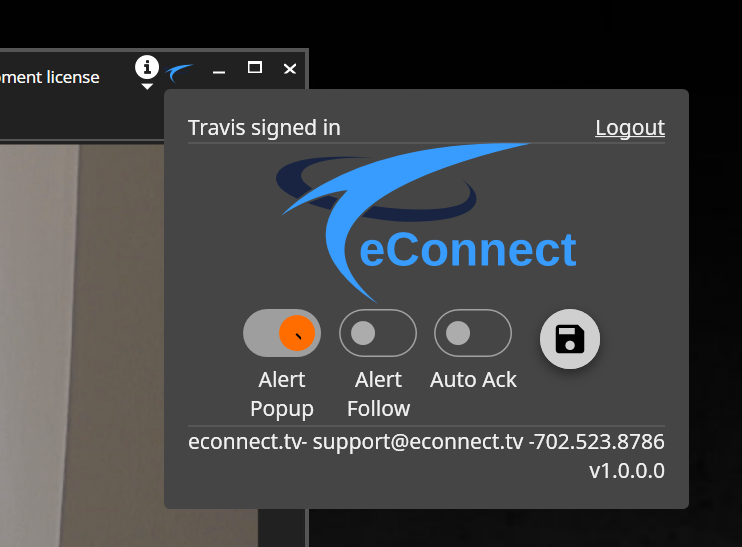Live Alerts
The Live Alerts system provides real-time notifications when faces or license plates of interest are detected. Alerts appear through the eConnect icon in the Mirasys toolbar and offer multiple response options to help operators manage security events effectively.
Alert System Overview
Live Alerts are triggered when the system detects:
- Tagged subjects matching your watch lists
- High-confidence matches of persons of interest
- License plates on alert lists
- Custom alert criteria based on your configuration
The alerts appear as notifications from the eConnect icon located in the top toolbar of the Mirasys interface.

eConnect Alert Icon Functions
The eConnect icon in the Mirasys toolbar serves multiple purposes:
Primary Functions:
- Login/Logout: Manage your eConnect session
- Alert Notifications: Receive real-time security alerts
- Alert Preferences: Configure how alerts are handled
Configuring Alert Preferences
Accessing Alert Settings:
- Click the eConnect Icon in the Mirasys toolbar
- Select Alert Preferences from the dropdown menu
- Configure your preferred alert handling options:
Available Alert Options:
- "Alert Popup" - Brings the alert to your attention with a visual notification, but requires manual action
- "Alert Follow" - Automatically opens a new tab to follow the detected face along with full context (name, tags, notes, etc.)
- "Auto Ack" - Alerts your peers that you've handled the message, preventing the alert from appearing on their screens
Alert Response Options:
1. Popup Alerts
- Enable popup alerts to receive immediate visual notifications
- Popup windows appear when new alerts are triggered
- Provides basic alert information for quick assessment
- Useful for immediate awareness of security events
2. Auto-Open Alert Context
- Enable auto-open to automatically display full alert context
- Live context display shows:
- All associated cameras in the area
- Looping playback of the detection event
- Subject profile and tag information
- Provides comprehensive situational awareness
- Ideal for detailed threat assessment
3. Auto-Acknowledge
- Enable auto-acknowledge to automatically mark alerts as being handled
- Prevents the same alert from opening on other operator workstations
- Useful in multi-operator environments to avoid duplicate responses
- Helps track which alerts are being actively managed
Screenshot needed: Alert preferences configuration panel showing all three options
Alert Workflow
When an Alert is Triggered:
- Initial Detection: System identifies a face or license plate of interest
- Alert Generation: Alert appears from eConnect icon
- Operator Response: Based on configured preferences:
- Popup only: Quick notification for awareness
- Auto-open: Full context window opens automatically
- Manual review: Operator clicks to view details
Alert Context Window:
When opened (manually or automatically), the alert context provides:
- Live camera feeds from detection location
- Looping playback of the detection event
- Subject information including tags and history
- Associated cameras in the surrounding area
- Action buttons for follow-up responses

Multi-Operator Considerations
Alert Distribution:
- Alerts can appear on multiple operator workstations simultaneously
- Auto-acknowledge feature helps coordinate responses
- Clear communication protocols should be established
Best Practices for Teams:
- Use auto-acknowledge to prevent duplicate investigations
- Establish escalation procedures for high-priority alerts
- Regular training on alert response protocols
Troubleshooting Alerts
Alerts Not Appearing:
- Verify eConnect connection status via the toolbar icon
- Check alert preferences are properly configured
- Ensure user permissions include alert access
Too Many False Alerts:
- Adjust detection confidence thresholds
- Review and refine tag configurations
- Update subject database with better quality images
- Consider location-based filtering
Missing Important Alerts:
- Verify subject tags are properly configured
- Check camera positioning and image quality
- Review alert filter settings
Best Practices
Configuration:
- Start conservative with alert settings and adjust based on experience
- Test alert preferences during low-activity periods
- Train all operators on alert response procedures
- Regular review of alert effectiveness and accuracy
Response:
- Immediate assessment of high-priority alerts
- Consistent documentation of alert responses and outcomes
- Coordinated response in multi-operator environments
- Regular debriefing to improve response protocols